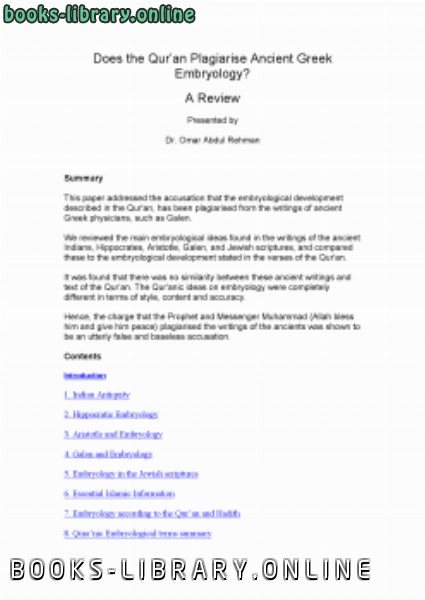📘 قراءة كتاب Does the Qur an Plagiarise Ancient Greek Embryology أونلاين


This paper addressed the accusation that the embryological development
described in the Qur'an, has been plagiarised from the writings of ancient
Greek physicians, such as Galen.
We reviewed the main embryological ideas found in the writings of the ancient
Indians, Hippocrates, Aristotle, Galen, and Jewish scriptures, and compared
these to the embryological development stated in the verses of the Qur'an.
It was found that there was no similarity between these ancient writings and
text of the Qur’an. The Qur'anic ideas on embryology were completely
different in terms of style, content and accuracy.
Hence, the charge that the Prophet and Messenger Muhammad (Allah bless
him and give him peace) plagiarised the writings of the ancients was shown to
be an utterly false and baseless accusation.
This paper will examine the claim that the embryological development
described in the Qur'an has been plagiarised from the writings of ancient
Greek physicians, such as Galen. Hence, we will review what was known
about embryology by the ancient Indians, Hippocrates, Aristotle, Galen, as
well as the embryology found in Jewish scriptures. Then we will outline all the
verses in the Qur’an, and some Hadith literature, regarding embryology and
human development. In doing so it should be very obvious if there are any
similarities or indeed outright plagiarism of Greek ideas which were prevalent
at the time.
It should be emphasised that translators of the Qur’an usually translate
according to their own understanding of the Arabic and choose words which
they think best convey the meaning. Therefore, it is all the more important to
refer back to classic Arabic dictionaries such as Lisan AI-'Arab, Taj AI-'Aroos
Min jawahir AI-Qamoos, and Al-Qamoos Al-Muhit. This approach will enable
us to eliminate any criticism of the Arabic translations and help us to
understand in what sense the word was originally used. Another interesting
aspect of Arabic is that it is a material language, in the sense that words are
based and derived from everyday material things, which are easy to identify.
So the Qur’anic descriptions of embryology use a simple yet comprehensive
language.
1. Indian Antiquity
Ancient Indian ideas about embryology are to found in the Bhagavad Gita (2
BC) which describes structures such as the amniotic membrane. And the
Susruta-samhita (2-3 AD), which says that the embryo is formed of a mixture
of semen and blood (this idea was also held by the Greeks, as we shall see
later), both of which originate from chyle (digested fats). The differentiation
into the various parts of the body, arms and head occurs in the third month. In
the fourth there follows the distinct development of thorax, abdomen and
heart. Hair, nails, sinews and veins develop in the sixth month; and in the
seventh month the embryo develops other things that may be necessary for it.
In the eighth month a drawing of the vital force (ojas) to and from mother and
embryo, which explains why the foetus is not yet viable. The hard parts body
are derived from the father, the soft from the mother. Nourishment is carried
on through vessels, which lead chyle from the mother
The factors required for the production of the foetus were thought to be
• • the father's semen
• • the mother's blood (sonita) or more specifically menstrual blood
(artava)
• • the atman, or subtle body (consisting of fire, earth, air and water in
the proper proportions)
• • the manas or mind, united to a particular embryo by reason of its
karma.
The idea of the blood being menstrual blood is interesting as it closely
resembles Aristotelian doctrine. The clotting of milk into cheese analogy used
by Aristotle for the formation of the embryo occurs also in Indian embryology.
The Susruta-samhita compares the creamy layers (santanika) formed in milk,
to semen and blood, which through chemical changes caused by heat,
produce seven different layers of skin (kala). This concept occurs again in a
Sutra on embryology written in Sanskrit, "Development, 0 Ananda," Buddha is
made to say, "is comparable to a vessel of milk, like as this ferments and
forms a kind of kefir or cheese." (A history of Embryology, J. Needham pp 25-
27, Cambridge, 2nd edition 1959).
2. Hippocratic Embryology
Hippocrates (460 – 377 BC) was a Greek physician and founder of the
Hippocratic school of medicine. The Hippocratic collection of some 60 or so
medical works is ascribed to various authors and was probably not written by
Hippocrates. The embryological knowledge of Hippocrates is set out in three
books, the treatise on Regimen, the work on The Seed the book on The
Nature of the Child (Hippocratic Writings, Penguin Classics, 1983).
In the treatise on Regimen section 9 discusses the formation of the embryo.
The description is based on the fundamental physiological idea at the time,
that is the two main constituents of all natural bodies are fire and water. Both
of these in turn consist of heat, dryness and moisture in differing proportions.
"Whatever may be the sex which chance gives to the embryo, it is set in
motion, being humid, by fire, and thus it extracts its nourishment from the food
and breath introduced into the mother. First of all this attraction is the same
throughout because the body is porous but by the motion and the fire it dries
up and solidifies as it solidifies, a dense outer crust is formed, and then the
fire inside cannot any more draw in sufficient nourishment and does not expel
the air because of the density of the surrounding surface. It therefore
consumes the interior humidity. In this way parts naturally solid being up to a
point hard and dry are not consumed to feed the fire but fortify and condense
themselves the more the humidity disappears-these are called bones and
nerves. The fire burns up the mixed humidity and forwards development
towards the natural disposition of the body in this manner; through the solid
and dry parts it cannot make permanent channels but it can do so through the
soft wet parts, for these are all nourishment to it. There is also in these parts a
certain dryness, which the fire does not consume, and they become
compacted one to another. Therefore the most interior fire, being closed
round on all sides, becomes the most abundant and makes the most canals
for itself (for that was the wettest part) and this is called the belly. Issuing out
from thence, and finding no nourishment outside, it makes the air pipes and
those for conducting and distributing food. As for the enclosed fire, it makes
three circulations in the body and what were the most humid parts become
the venae cavae. In the intermediate part the remainder of the water contracts
and hardens forming the flesh."
Further in section 26 of the same treatise;
"Everything in the embryo is formed simultaneously. All the limbs separate
themselves at the same time and so grow, none comes before or after other,
but those, which are naturally bigger appear before the smaller, without being
formed earlier. Not all embryos form themselves in an equal time but some
earlier and some later according to whether they meet with fire and food,
some have everything visible in 40 days, others in 2 months, 3, or 4. They
also become visible at variable times and show themselves to the light having
the blend (of fire and water) which they always will have."
In the treatise on The Seed sections 5-7.
"When a woman has intercourse, if she is not going to conceive, then it is her
practice to expel the sperm produced by both partners whenever she wishes
to do so. If however she is going to conceive, the sperm is not expelled, but
retained by the womb. For when the womb has received the sperm closes up
and retains it, because the moisture causes the womb orifice to contract.
Then both what is provided by the man and what is provided by the woman is
mixed together. if the woman is experienced in matters of childbirth, and takes
when the sperm is retained, she will know the precise day, which she has
conceived.
Now here is a further point. What the woman emits is sometimes stronger,
and sometimes weaker; and this applies also to what the man emits. In fact
both partners alike contain both male and female sperm (the male being
stronger than the female must of course originate from a stronger sperm Here
is a further point: if (a) both partners produce a strong sperm, then a male is
the result, whereas if (b) they produce a weak form, then a female is the
result. But if (c) one part produces one kind of sperm, and the other another,
then the resultant sex is determined by whichever sperm prevails in quantity.
For suppose that the weaker sperm is much greater in quantity than the
stronger sperm then the stronger is overwhelmed and, being mixed with the
weak results in a female. If on the contrary the strong sperm is greater in
quantity than the weak, and the weak is overwhelmed then it results in a
male."
In Section 8 sperm is said to come from the whole body of each parent, weak
coming from the weak parts, and strong from the strong parts.
In the treatise on The Nature of the Child (section 14, p.326) it is stated that
the embryo is nourished by maternal blood, which flows to the foetus and
coagulates, forming the embryonic flesh. Section 15 describes the umbilical
as the means by which foetal respiration is carried on.
Section 17 describes the development of the embryo.
As the flesh grows it is formed into distinct members by breath. Each thing in
it goes to its similar - the dense to dense, the rare to the rare, and the fluid to
the fluid. Each settles in its appropriate place, corresponding to the part from
which it came and to which it is akin. I mean that those parts which came from
a dense part in the parent body are themselves dense, while those from a
fluid part are fluid, and with all the other parts: they all obey the same formula
in the process of growth. The bones grow hard as a result of coagulating
action of heat; moreover they send out branches like a tree. Both the internal
and external parts of the body now become more distinctly articulated. The
head begins to project from the shoulders, and the upper and lower arms from
the sides. The legs separate from each other, and the sinews spring up
around the joints. The mouth opens up. The nose and ears project from the
flesh and become perforated, while the eyes are filled with a clear fluid1
. The
sex of genitals becomes plain. The entrails too are formed into distinct parts.
Moreover, the upper portions of the body now respire through the mouth and
nostrils, with the result the belly is inflated and the intestines, inflated from
above, cut off respiration through the umbilicus and put an end to it. A
passage outside is formed from the belly and intestine through the anus, and
another one through the bladder.
18. Sections 18 continues that the period of articulation (the period in which
the limbs are differentiated)is forty-two days for the female and for a boy thirty
days.
By now the foetus is formed. This stage is reached, for the female foetus, in
forty-two days at maximum, and for the male, in thirty days at maximum. This
is the period for articulation in most cases, take or give a little. And the lochial
discharge too after birth is usually completed within forty-two days if the child
is a girl. At least this is the longest period, which completes it, but it would still
be safe even if it took only twenty-five days. If the child is a boy, the discharge
takes thirty days - again the longest period, but there is no danger even if it
takes only twenty days. During the latter part of the period the amount which
flows is very small. In young women, the discharge takes a smaller number of
days; more, when women are older. It is the women who are having their first
child who suffer the most pain during the birth and during the subsequent
discharge, and those who have had fewer children suffer more than those
who have had a greater number."
Section 22 –27 compares the animal embryo with plant seeds, and concludes
that from beginning to end the process of growth in plants and in humans is
exactly the same.
A book, in pdf format, authored by Omar Abdel Rahman, one of the most prominent messages that discuss the important suspicion is that embryology in the Koran, stolen from the ancient Greek culture.
In this study, the author reviewed the Greek and Indian sources, read the works of Aristotle, the Apocrypha, and even the Jewish literature, and then compared all these sources to the Koran, to prove that this science and what was written in the book is not stolen or preceded by cultures and religions Other.
سنة النشر : 1959م / 1378هـ .
حجم الكتاب عند التحميل : 329.7 كيلوبايت .
نوع الكتاب : pdf.
عداد القراءة:
اذا اعجبك الكتاب فضلاً اضغط على أعجبني و يمكنك تحميله من هنا:

شكرًا لمساهمتكم
شكراً لمساهمتكم معنا في الإرتقاء بمستوى المكتبة ، يمكنكم االتبليغ عن اخطاء او سوء اختيار للكتب وتصنيفها ومحتواها ، أو كتاب يُمنع نشره ، او محمي بحقوق طبع ونشر ، فضلاً قم بالتبليغ عن الكتاب المُخالف:
 قبل تحميل الكتاب ..
قبل تحميل الكتاب ..
يجب ان يتوفر لديكم برنامج تشغيل وقراءة ملفات pdf
يمكن تحميلة من هنا 'http://get.adobe.com/reader/'


 منصّة المكتبة
منصّة المكتبة 